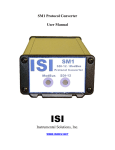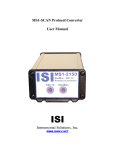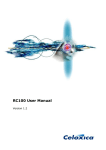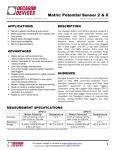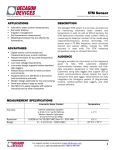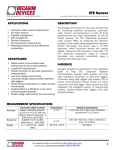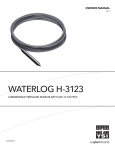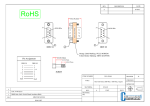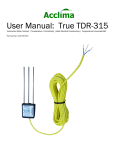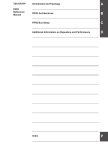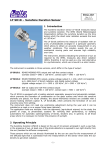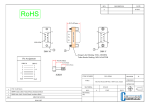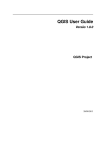Download MS1-2150 Protocol Converter User Manual Instrumental Solutions
Transcript
MS1-2150 Protocol Converter User Manual Firmware version 2.0 ISI Instrumental Solutions, Inc. WWW.ISIDEV.NET Introduction The MS1-2150 protocol converter can take readings from 1 or more ModBus registers on up to 2 ModBus instruments using an RS485 or RS232 interface, and make that data available on a SDI-12 network. It is preconfigured to read the Level, Velocity, Flow, Volume and Temperature registers on an Isco 2150 Area Velocity Flow Module. For special situations, the unit can be reconfigured via the text-based user interface using most any terminal software. Getting Started All wiring connections are made inside the weatherproof enclosure, with the wires passing through the waterproof fitting on the rear panel of the enclosure. Remove the rear panel by removing the 4 retaining screws and slide the circuit board out to gain access to the connectors (see Figure 1). For testing purposes, the 2150 can be plugged directly in to the DB9P connector labeled “RS-232” using Isco’s Serial Communication cable (Isco Part #60-2004046, not included). However, permanent installations should use screw terminals 4-6 labeled “GND”, “232 TX”, and “232 RX”, respectively. See Tables 1 & 2 for more information on making electrical connections. The DB9P connector is also used for configuring the MS1-2150. A nullmodem serial cable and terminal program (such as Hyperterm) is required to do this. When configuring the MS1-2150, the Isco 2150 must be disconnected from the converter. The MS1-2150 is preconfigured to operate with the Isco 2150, and configuration is not normally required. The converter has 2 multi-color LED indicators on the front panel for indicating SDI-12 and Modbus data activity. The indicators light up green when the converter is receiving data on the associated interface, and red when the converter is sending data on the interface. These can be used to help diagnose communication problems. © Copyright 2011 Instrumental Solutions, Inc. All Rights Reserved Figure 1 © Copyright 2011 Instrumental Solutions, Inc. All Rights Reserved Pin 1 Pin 2 Pin 3 Pin 4 Pin 5 Pin 6 Pin 7 Pin 8 Pin 9 Table 1 - DB9P Connections No connection Receive data – RS232 input Transmit data – RS232 output DTR – internally tied to pin 6 for flow control loopback Signal ground DSR – internally tied to pin 4 for flow control loopback RTS – internally tied to pin 8 for flow control loopback CTS – internally tied to pin 7 for flow control loopback No connection Table 2 – Terminal Connections #1 SDI-12 data line #2 SDI-12 ground #3 +12VDC input #4 Ground #5 Transmit data – RS232 output #6 Receive data – RS232 input #7 RS485 line A #8 RS485 line B Table 3 – Jumper J6 Jumper installed on 1 & 2 Enable RS-232 operation Jumper installed on 2 & 3 Enable RS-485 operation Default Configuration To view the current configuration or configure the MS1-2150, make sure that the jumper on header J6 (which is located immediately behind the screw-terminal block) is in position 1-2. This is the normal position (RS-232 enabled) when using the MS1-2150 with an Isco 2150. Position 2-3 is used when connecting to a device with a RS-485 interface. Please refer to Table 3 above and the highlighted portion in Figure 1, where the jumper is shown in position 2-3 (RS-485 enabled). © Copyright 2011 Instrumental Solutions, Inc. All Rights Reserved Next, disconnect any wires that are connected to the RS-232 screw terminals, then plug one end of a null-modem cable into the DB9P connector on the converter, and the other end into an available serial port on a PC. Terminal software should be set for 9600 baud, 8 data bits, no parity, and no flow control. To enter configuration mode, quickly type 3 question-mark characters. The MS1-2150 should respond with the following screen: NOTE: If the converter fails to respond, try again, typing as quickly as you can. If still no response, remove and re-apply power to the converter while watching the front panel LEDs. Both LEDs should immediately light up red, then turn green after about half a second, then go out after another halfsecond. If this doesn’t happen, check the power wiring for proper voltage and polarity. The MS1-2150 operates on 9-14 volts DC. If the LEDs don’t light when power is applied, there is a problem with the converter. If the LEDs light but there is still no response after typing question marks, make sure that you are using a null-modem serial cable, which crosses pins 2 & 3 between ends. If the unit fails to respond, there may be a problem with the converter. © Copyright 2011 Instrumental Solutions, Inc. All Rights Reserved The default configuration returns fields to the SDI-12 master in the following order: Level, Velocity, Flow, Volume, and Temperature. To change a configuration setting, type the number of the setting followed by the Enter key. The configuration mode has an inactivity timeout of 1 minute. If at any point during configuration the user goes 1 minute without typing anything, the converter automatically returns to normal online operation. Setting changes are saved as they are entered, so any changes completed during the configuration session will not be lost if a inactivity timeout occurs. The following section describes each setting in detail. 1. Modbus operations 1-12 Upon receiving a measurement request from the SDI-12 master, the MS1-2150 executes a series of Modbus operations, as defined by these settings. An operation can be 1 of 3 types: a Read type (which reads a Modbus register on the attached sensor), a Write type (which writes a Modbus register on the attached sensor), or a Test type (which repeatedly reads a Modbus register on the attached sensor until the value read matches a “test” value specified in the operation). For example, to initiate a data sample on the Isco 2150, Modbus register number 25 must be written to a 1, which tells the 2150 to take a sample. Operation #1 accomplishes this: 1. Modbus operation 1 [*] [W] [1] Take-reading flag,set The [*] indicates that this particular operation is enabled. A disabled operation appears as [ ]. The [W] indicates that this is a Write operation. The [1] indicates that this operation uses virtual device 1. Virtual devices are discussed in the Virtual Devices section below. The “Take-reading flag,set” text is a plain-text description of what the operation does. To view or modify the details of a Modbus operation, type its menuselection number and hit Enter. For example, to view/modify operation #1 (menu selection 1), type 1 and hit Enter. You will be led through the following dialog: © Copyright 2011 Instrumental Solutions, Inc. All Rights Reserved 1. Modbus operation 1 Enabled: Yes (Spacebar to change, Enter to accept) The spacebar will toggle this setting between Yes and No. Press the ENTER key to accept the setting and take you to the next step: [Modbus register] Current setting: 25 New setting: Enter a new value for the Modbus register, or hit Enter with no entry to keep the current setting. In this case, we are operating on register 25, which is the take-reading flag register in the Isco 2150. Data type: 16-bit signed integer accept) (Spacebar to change, Enter to The spacebar steps through all of the data types supported by the MS12150. This setting must agree with the data type of the Modbus register being referenced. In this case, register number 25 in the Isco 2150 has a data type of 16-bit integer. Press the ENTER key to accept the setting and take you to the next step: Type of operation: Write (Spacebar to change, Enter to accept) The spacebar steps through the available types for this operation. In this case, we want to Write to the specified register on the Isco 2150. [Operation data] Current setting: 1 New setting: Enter the data value to write to the Modbus register. In this case, we write a 1 to initiate a sample on the Isco 2150. [Operation name] Current setting: Take-reading flag,set New setting: This is a free-form text description of what the operation does. Hit Enter with no entry to keep the current setting. The final setting for a Modbus operation is to select the virtual device that the operation will use. The default configuration has 1 virtual device © Copyright 2011 Instrumental Solutions, Inc. All Rights Reserved defined, “Isco 2150”. If there is more than one virtual device defined, the spacebar is used to select the device to use. In this case, we want to use the device named “Isco 2150”: Virtual device: Isco 2150 accept) (Spacebar to change, Enter to So, Operation #1 initiates a data sample on the 2150. What happens now? Operation #2 executes next. This is a Test type of operation that causes the MS1-2150 to wait for the 2150 to make sample data available. It does this by repeatedly reading Modbus register 25 on the 2150 and looking for it to change from 1 (the value that was written to it by Operation #1) to 0, which indicates that data is ready to be read. This operation will wait up to half the SDI-12 data-ready time (defined in the virtual device) for the test condition to become true. After the Test operation finishes (whether due to the test condition becoming true or a timeout occurring), the converter continues with Operations 3 – 7, which are all Read-type operations. Each operation reads a data field from the 2150, and returns them all to the SDI-12 master. Virtual Devices The MS1-2150 can support up to 2 SDI-12 addresses on the SDI-12 network, and 2 addresses on the Modbus network. A virtual device must exist for each Modbus address to be used. The virtual device defines operating characteristics such as the SDI-12 and Modbus addresses, Modbus mode (ASCII/RTU), the Modbus function code used to read a register, and the SDI-12 timeout value. Basically, the virtual device controls the mapping of SDI-12 requests (based on the SDI-12 address specified by the master) to Modbus addresses. The MS1-2150 can answer to up to 2 SDI-12 addresses, and map these to up to 2 Modbus addresses. The default configuration for the MS1-2150 is one Virtual device that uses SDI-12 address 0, Modbus address 2, Modbus ASCII mode, and a read function code of 3. This configuration is required to work properly with the Isco 2150. Another typical configuration is to set Virtual device 1 with SDI-12 address 0 and Modbus address 0, and Virtual device 2 with SDI-12 address 1 and Modbus address 1. When the SDI-12 master requests a measurement from SDI-12 address 0, the MS1-2150 will answer it and execute only the Modbus operations that are set to use Virtual device 1, © Copyright 2011 Instrumental Solutions, Inc. All Rights Reserved and the operations will be directed to Modbus device address 0. Likewise, SDI-12 requests directed to SDI-12 address 1 will also be answered, and only the Modbus operations that use Virtual device 2 will be executed, using Modbus address 1. The result is 2 individual data channels that have no interaction with each other. Another possibility is to set the SDI-12 address the same in both virtual devices. In this case, the MS1-2150 will answer only to that address, but will execute all of Modbus operations (assuming they are enabled), even if more than one Modbus device address is defined. The MS1-2150 will then combine the data from both Modbus devices into a single SDI-12 response. This is particularly useful with Isco’s stackable devices, where each device on the stack is automatically assigned a unique Modbus address. 13. Virtual device 1 14. Virtual device 2 These options allow you to view and configure the virtual devices. The following section describes each setting: 1. Virtual device name This is the name that the user wants to assign to the virtual device. The name shows up in the list of available devices when configuring a Modbus operation. 2. SDI12 address This is the address that the MS1-2150 will answer to on the SDI-12 network. The default value is 0. This value must match the address that the SDI-12 master uses when attempting to communicate with the MS12150. If the SDI-12 master has the ability to scan the network for sensors, this is the address that will be associated with MS1-2150 on the SDI-12 master. 3. SDI12 data-ready time This is the maximum length of time in seconds that the Modbus device should take to have data available after a measurement request. The default value is 90. The MS1-2150 reports this value back to the SDI-12 master in response to a measurement request. The SDI-12 master must wait this length of time before requesting data from the MS1-2150. However, if the SDI-12 master issues a non-concurrent measurement request (recommended), the MS1-2150 will issue a Service Request to © Copyright 2011 Instrumental Solutions, Inc. All Rights Reserved the SDI-12 master as soon as data is available from the Modbus device. This causes the SDI-12 master to immediately issue a data retrieval request, even if the data-ready time has not been reached. This can significantly speed up the data retrieval cycle. For more information concerning the SDI-12 protocol, see http://www.sdi-12.org. 4. Modbus address This is the address that the MS1-2150 will send Modbus requests to on the RS232 interface. The default value is 2. To ensure proper operation with the Isco 2150, this value should not be changed. 5. Modbus mode This sets the Modbus operating mode. The choices are ASCII and RTU. Modbus ASCII is required for use with the Isco 2150. 6. Modbus read function This sets the function code that will be sent to the Modbus device to read the data holding registers. This must be set to 3 for the Isco 2150. 15. Restore default settings This selection resets all configuration parameters to the factory-default settings. 16. Resume normal operation This selection exits configuration mode and returns the converter to online operation. Configuration mode has an inactivity timeout of 1 minute; if at any time after entering configuration mode no characters are typed for 1 minute, the converter will automatically return to normal online operation. If this occurs in the middle of configuring a Modbus operation, no changes will be made to the configuration. Modbus operation changes are not saved until the user has stepped through all of the settings for the operation. SDI-12 Commands The MS1-2150 is compliant with version 1.3 of the SDI-12 specification, which is the most recent version as of the firmware v2.0 release date. © Copyright 2011 Instrumental Solutions, Inc. All Rights Reserved The following SDI-12 commands are supported: Name Command Acknowledge Active Send Identification Change Address Address Query a! aI! aAb! ?! Start Measurement Start Measurement w/CRC Send Data Additional Measurements Additional Measurements w/CRC Start Verification aM! aMC! aD0! … aD9! aM1! … aM9! May result in a service request. aMC1! … May result in a service request. aMC9! aV! The next Send Data command will return MS1-2150 status information in the format of 4 integer values. These values represent the number of invalid SDI-12 commands received, the number of Modbus CRC errors, the number of Modbus read timeouts, and the number of timeouts that have occurred during a Modbus “Test” operation. aC! Start Concurrent Measurement Start Concurrent Measurement w/CRC Additional Concurrent Measurements Additional Concurrent Measurements w/CRC Continuous Measurements Continuous Measurements w/CRC Comment See SDI-12 spec for response format. Does not change device configuration. Returns the address in the first Virtual Device or the address for the last command that was responded to. May result in a service request. May result in a service request. aCC! aC1! … aC9! aCC1! … aCC9! aR0! … aR9! aRC0! … aRC9! Not applicable with MS1-2150 – a<CR><LF> always returned, where “a” is the SDI-12 address. Not applicable with MS1-2150 – a<CR><LF> always returned, where “a” is the SDI-12 address. © Copyright 2011 Instrumental Solutions, Inc. All Rights Reserved Specifications SDI-12 interface: Modbus interface: Text interface: Operating system: Indicators: Connections: Temperature range: Power requirements: Enclosure: External dimensions: Weight: SDI-12 v1.3 compliant Modbus ASCII or RTU, RS232 or RS485, 9600 baud, 8-bit, no parity 9600 baud, 8-bit, no parity, no handshake Instrumental Solutions ISOS-11 2 bicolor LEDs for transmit/receive indication Internal screw terminals, DB9 male (DTE) -40°C to +85°C 12VDC 35ma idle, 35 ma avg, 55ma max Extruded aluminum, IP65 rated 7.52” (19.1cm) L, 3.48” (8.84cm) W, 1.85” (4.7cm) H 15 ounces SDI-12 Verification Report The MS1-2150 has been verified with the NR Systems SDI-12 verifier and has passed all tests in the comprehensive sensor test suite. The results are available at: http://isidev.net/yahoo_site_admin/assets/docs/SDI12VerificationReport.310132059.pdf © Copyright 2011 Instrumental Solutions, Inc. All Rights Reserved












